Project Management Report: Analysis of East Timor Solar Power Project
VerifiedAdded on 2022/12/19
|11
|2740
|265
Report
AI Summary
This report presents a comprehensive analysis of the International Project Management of the East Timor solar project initiated by Alternative Technology Associate (ATA). The project aims to provide affordable and sustainable solar power to East Timor residents. The report includes an executive summary, project description, project management plan, and risk management plan. The project management plan details the execution strategy, including training local technicians, calculating costs, and the role of Google Impact's funding. The risk management plan identifies potential risks such as lack of community support, language barriers, and contractor transparency. The report assesses the impact of these risks and proposes mitigation strategies. The project's success hinges on effective planning, community engagement, and proactive risk management. The report concludes by highlighting the significance of the project in improving the economic and social well-being of East Timor residents.

International Project Management 1
INTERNATIONAL PROJECT MANAGEMENT
by [Name]
Professor’s Name
Course Title
Course Code
City/State
Date
INTERNATIONAL PROJECT MANAGEMENT
by [Name]
Professor’s Name
Course Title
Course Code
City/State
Date
Paraphrase This Document
Need a fresh take? Get an instant paraphrase of this document with our AI Paraphraser
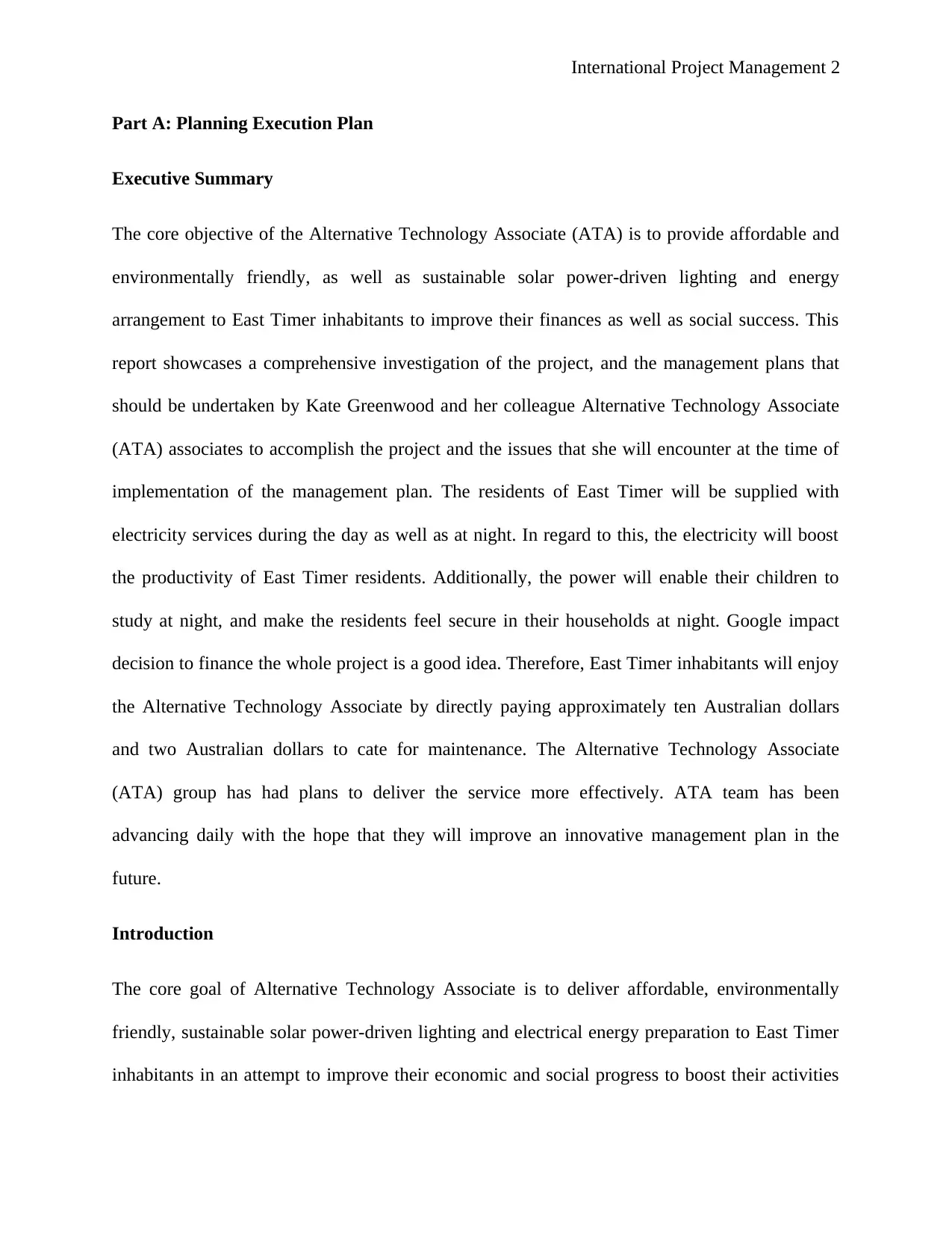
International Project Management 2
Part A: Planning Execution Plan
Executive Summary
The core objective of the Alternative Technology Associate (ATA) is to provide affordable and
environmentally friendly, as well as sustainable solar power-driven lighting and energy
arrangement to East Timer inhabitants to improve their finances as well as social success. This
report showcases a comprehensive investigation of the project, and the management plans that
should be undertaken by Kate Greenwood and her colleague Alternative Technology Associate
(ATA) associates to accomplish the project and the issues that she will encounter at the time of
implementation of the management plan. The residents of East Timer will be supplied with
electricity services during the day as well as at night. In regard to this, the electricity will boost
the productivity of East Timer residents. Additionally, the power will enable their children to
study at night, and make the residents feel secure in their households at night. Google impact
decision to finance the whole project is a good idea. Therefore, East Timer inhabitants will enjoy
the Alternative Technology Associate by directly paying approximately ten Australian dollars
and two Australian dollars to cate for maintenance. The Alternative Technology Associate
(ATA) group has had plans to deliver the service more effectively. ATA team has been
advancing daily with the hope that they will improve an innovative management plan in the
future.
Introduction
The core goal of Alternative Technology Associate is to deliver affordable, environmentally
friendly, sustainable solar power-driven lighting and electrical energy preparation to East Timer
inhabitants in an attempt to improve their economic and social progress to boost their activities
Part A: Planning Execution Plan
Executive Summary
The core objective of the Alternative Technology Associate (ATA) is to provide affordable and
environmentally friendly, as well as sustainable solar power-driven lighting and energy
arrangement to East Timer inhabitants to improve their finances as well as social success. This
report showcases a comprehensive investigation of the project, and the management plans that
should be undertaken by Kate Greenwood and her colleague Alternative Technology Associate
(ATA) associates to accomplish the project and the issues that she will encounter at the time of
implementation of the management plan. The residents of East Timer will be supplied with
electricity services during the day as well as at night. In regard to this, the electricity will boost
the productivity of East Timer residents. Additionally, the power will enable their children to
study at night, and make the residents feel secure in their households at night. Google impact
decision to finance the whole project is a good idea. Therefore, East Timer inhabitants will enjoy
the Alternative Technology Associate by directly paying approximately ten Australian dollars
and two Australian dollars to cate for maintenance. The Alternative Technology Associate
(ATA) group has had plans to deliver the service more effectively. ATA team has been
advancing daily with the hope that they will improve an innovative management plan in the
future.
Introduction
The core goal of Alternative Technology Associate is to deliver affordable, environmentally
friendly, sustainable solar power-driven lighting and electrical energy preparation to East Timer
inhabitants in an attempt to improve their economic and social progress to boost their activities
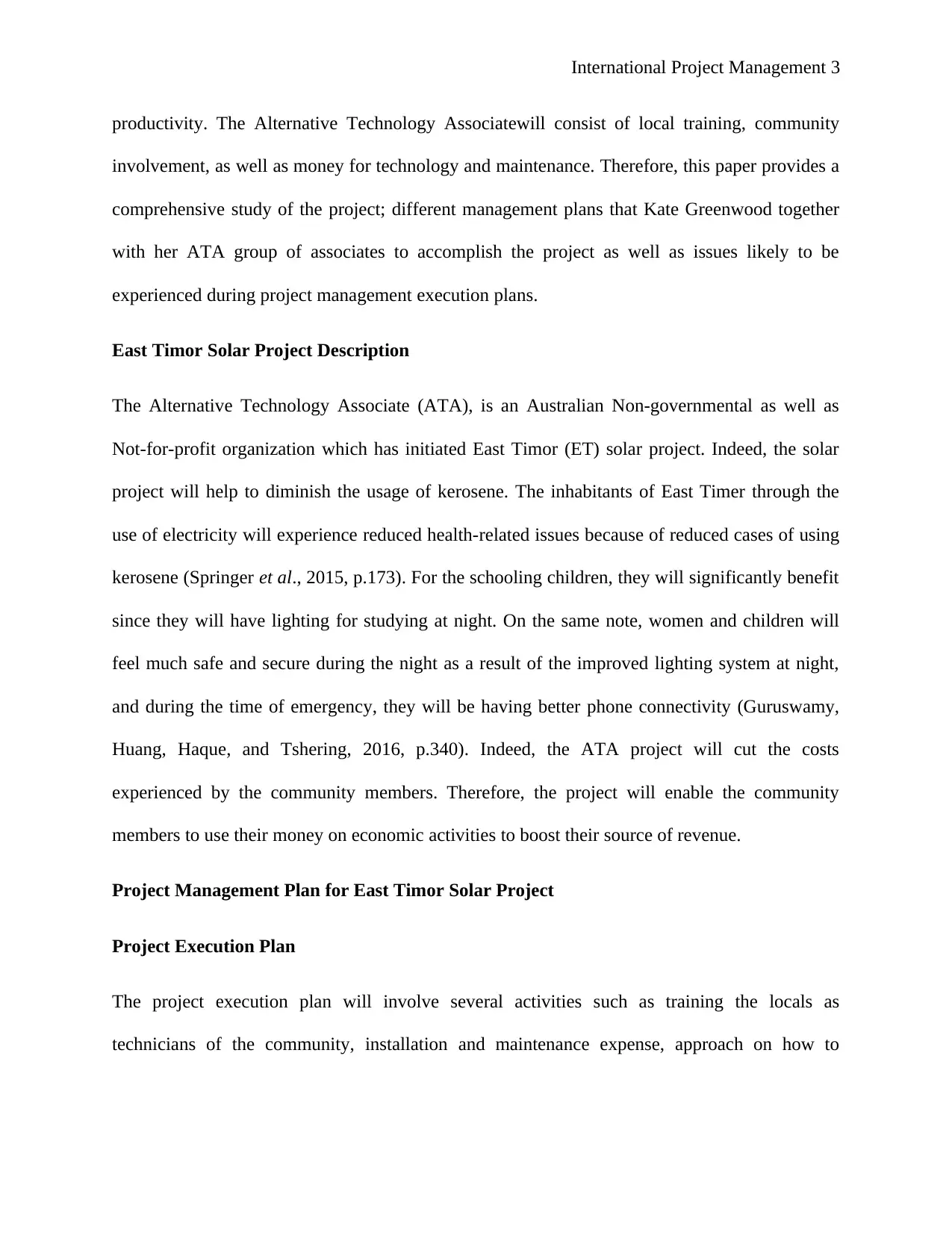
International Project Management 3
productivity. The Alternative Technology Associatewill consist of local training, community
involvement, as well as money for technology and maintenance. Therefore, this paper provides a
comprehensive study of the project; different management plans that Kate Greenwood together
with her ATA group of associates to accomplish the project as well as issues likely to be
experienced during project management execution plans.
East Timor Solar Project Description
The Alternative Technology Associate (ATA), is an Australian Non-governmental as well as
Not-for-profit organization which has initiated East Timor (ET) solar project. Indeed, the solar
project will help to diminish the usage of kerosene. The inhabitants of East Timer through the
use of electricity will experience reduced health-related issues because of reduced cases of using
kerosene (Springer et al., 2015, p.173). For the schooling children, they will significantly benefit
since they will have lighting for studying at night. On the same note, women and children will
feel much safe and secure during the night as a result of the improved lighting system at night,
and during the time of emergency, they will be having better phone connectivity (Guruswamy,
Huang, Haque, and Tshering, 2016, p.340). Indeed, the ATA project will cut the costs
experienced by the community members. Therefore, the project will enable the community
members to use their money on economic activities to boost their source of revenue.
Project Management Plan for East Timor Solar Project
Project Execution Plan
The project execution plan will involve several activities such as training the locals as
technicians of the community, installation and maintenance expense, approach on how to
productivity. The Alternative Technology Associatewill consist of local training, community
involvement, as well as money for technology and maintenance. Therefore, this paper provides a
comprehensive study of the project; different management plans that Kate Greenwood together
with her ATA group of associates to accomplish the project as well as issues likely to be
experienced during project management execution plans.
East Timor Solar Project Description
The Alternative Technology Associate (ATA), is an Australian Non-governmental as well as
Not-for-profit organization which has initiated East Timor (ET) solar project. Indeed, the solar
project will help to diminish the usage of kerosene. The inhabitants of East Timer through the
use of electricity will experience reduced health-related issues because of reduced cases of using
kerosene (Springer et al., 2015, p.173). For the schooling children, they will significantly benefit
since they will have lighting for studying at night. On the same note, women and children will
feel much safe and secure during the night as a result of the improved lighting system at night,
and during the time of emergency, they will be having better phone connectivity (Guruswamy,
Huang, Haque, and Tshering, 2016, p.340). Indeed, the ATA project will cut the costs
experienced by the community members. Therefore, the project will enable the community
members to use their money on economic activities to boost their source of revenue.
Project Management Plan for East Timor Solar Project
Project Execution Plan
The project execution plan will involve several activities such as training the locals as
technicians of the community, installation and maintenance expense, approach on how to
⊘ This is a preview!⊘
Do you want full access?
Subscribe today to unlock all pages.

Trusted by 1+ million students worldwide
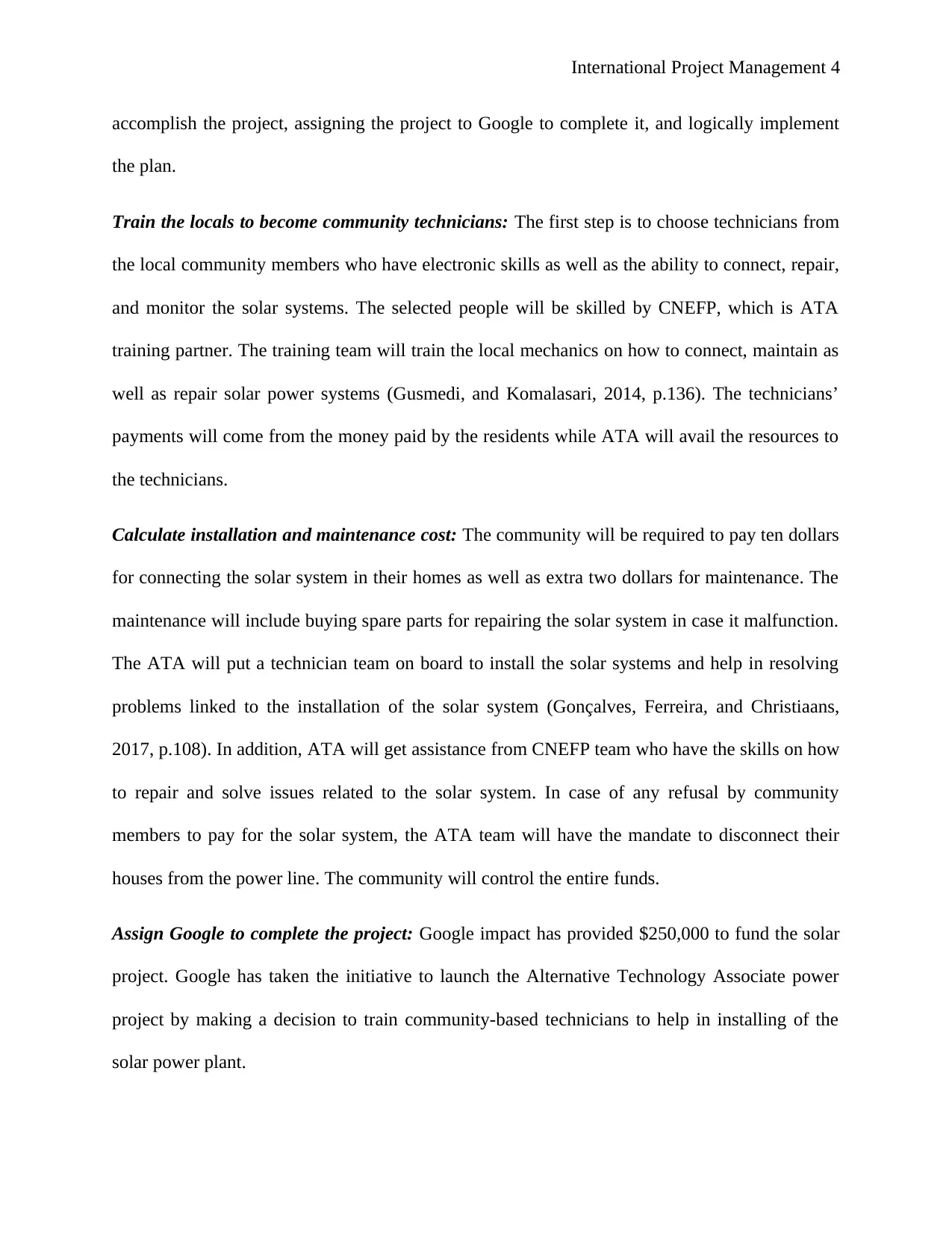
International Project Management 4
accomplish the project, assigning the project to Google to complete it, and logically implement
the plan.
Train the locals to become community technicians: The first step is to choose technicians from
the local community members who have electronic skills as well as the ability to connect, repair,
and monitor the solar systems. The selected people will be skilled by CNEFP, which is ATA
training partner. The training team will train the local mechanics on how to connect, maintain as
well as repair solar power systems (Gusmedi, and Komalasari, 2014, p.136). The technicians’
payments will come from the money paid by the residents while ATA will avail the resources to
the technicians.
Calculate installation and maintenance cost: The community will be required to pay ten dollars
for connecting the solar system in their homes as well as extra two dollars for maintenance. The
maintenance will include buying spare parts for repairing the solar system in case it malfunction.
The ATA will put a technician team on board to install the solar systems and help in resolving
problems linked to the installation of the solar system (Gonçalves, Ferreira, and Christiaans,
2017, p.108). In addition, ATA will get assistance from CNEFP team who have the skills on how
to repair and solve issues related to the solar system. In case of any refusal by community
members to pay for the solar system, the ATA team will have the mandate to disconnect their
houses from the power line. The community will control the entire funds.
Assign Google to complete the project: Google impact has provided $250,000 to fund the solar
project. Google has taken the initiative to launch the Alternative Technology Associate power
project by making a decision to train community-based technicians to help in installing of the
solar power plant.
accomplish the project, assigning the project to Google to complete it, and logically implement
the plan.
Train the locals to become community technicians: The first step is to choose technicians from
the local community members who have electronic skills as well as the ability to connect, repair,
and monitor the solar systems. The selected people will be skilled by CNEFP, which is ATA
training partner. The training team will train the local mechanics on how to connect, maintain as
well as repair solar power systems (Gusmedi, and Komalasari, 2014, p.136). The technicians’
payments will come from the money paid by the residents while ATA will avail the resources to
the technicians.
Calculate installation and maintenance cost: The community will be required to pay ten dollars
for connecting the solar system in their homes as well as extra two dollars for maintenance. The
maintenance will include buying spare parts for repairing the solar system in case it malfunction.
The ATA will put a technician team on board to install the solar systems and help in resolving
problems linked to the installation of the solar system (Gonçalves, Ferreira, and Christiaans,
2017, p.108). In addition, ATA will get assistance from CNEFP team who have the skills on how
to repair and solve issues related to the solar system. In case of any refusal by community
members to pay for the solar system, the ATA team will have the mandate to disconnect their
houses from the power line. The community will control the entire funds.
Assign Google to complete the project: Google impact has provided $250,000 to fund the solar
project. Google has taken the initiative to launch the Alternative Technology Associate power
project by making a decision to train community-based technicians to help in installing of the
solar power plant.
Paraphrase This Document
Need a fresh take? Get an instant paraphrase of this document with our AI Paraphraser
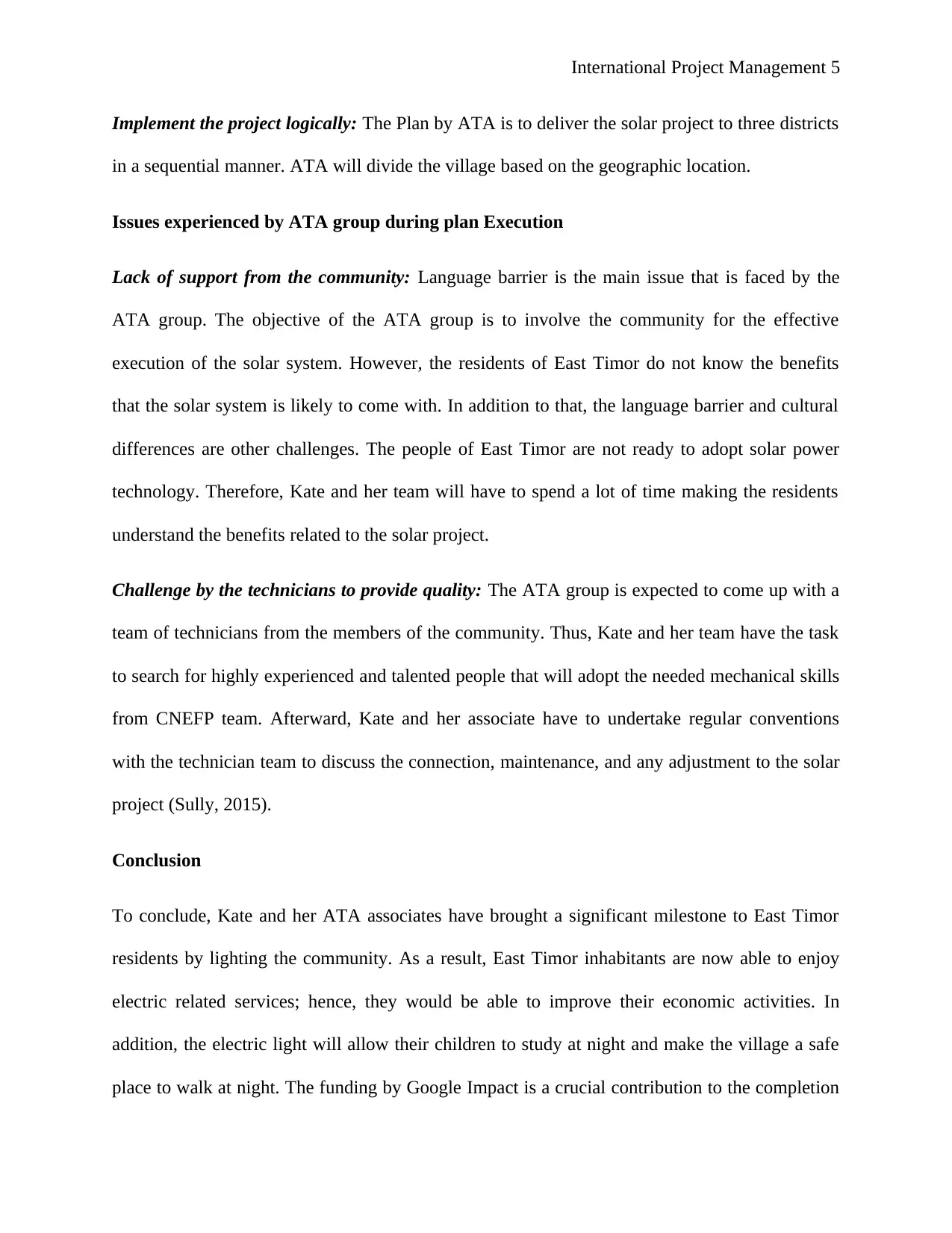
International Project Management 5
Implement the project logically: The Plan by ATA is to deliver the solar project to three districts
in a sequential manner. ATA will divide the village based on the geographic location.
Issues experienced by ATA group during plan Execution
Lack of support from the community: Language barrier is the main issue that is faced by the
ATA group. The objective of the ATA group is to involve the community for the effective
execution of the solar system. However, the residents of East Timor do not know the benefits
that the solar system is likely to come with. In addition to that, the language barrier and cultural
differences are other challenges. The people of East Timor are not ready to adopt solar power
technology. Therefore, Kate and her team will have to spend a lot of time making the residents
understand the benefits related to the solar project.
Challenge by the technicians to provide quality: The ATA group is expected to come up with a
team of technicians from the members of the community. Thus, Kate and her team have the task
to search for highly experienced and talented people that will adopt the needed mechanical skills
from CNEFP team. Afterward, Kate and her associate have to undertake regular conventions
with the technician team to discuss the connection, maintenance, and any adjustment to the solar
project (Sully, 2015).
Conclusion
To conclude, Kate and her ATA associates have brought a significant milestone to East Timor
residents by lighting the community. As a result, East Timor inhabitants are now able to enjoy
electric related services; hence, they would be able to improve their economic activities. In
addition, the electric light will allow their children to study at night and make the village a safe
place to walk at night. The funding by Google Impact is a crucial contribution to the completion
Implement the project logically: The Plan by ATA is to deliver the solar project to three districts
in a sequential manner. ATA will divide the village based on the geographic location.
Issues experienced by ATA group during plan Execution
Lack of support from the community: Language barrier is the main issue that is faced by the
ATA group. The objective of the ATA group is to involve the community for the effective
execution of the solar system. However, the residents of East Timor do not know the benefits
that the solar system is likely to come with. In addition to that, the language barrier and cultural
differences are other challenges. The people of East Timor are not ready to adopt solar power
technology. Therefore, Kate and her team will have to spend a lot of time making the residents
understand the benefits related to the solar project.
Challenge by the technicians to provide quality: The ATA group is expected to come up with a
team of technicians from the members of the community. Thus, Kate and her team have the task
to search for highly experienced and talented people that will adopt the needed mechanical skills
from CNEFP team. Afterward, Kate and her associate have to undertake regular conventions
with the technician team to discuss the connection, maintenance, and any adjustment to the solar
project (Sully, 2015).
Conclusion
To conclude, Kate and her ATA associates have brought a significant milestone to East Timor
residents by lighting the community. As a result, East Timor inhabitants are now able to enjoy
electric related services; hence, they would be able to improve their economic activities. In
addition, the electric light will allow their children to study at night and make the village a safe
place to walk at night. The funding by Google Impact is a crucial contribution to the completion
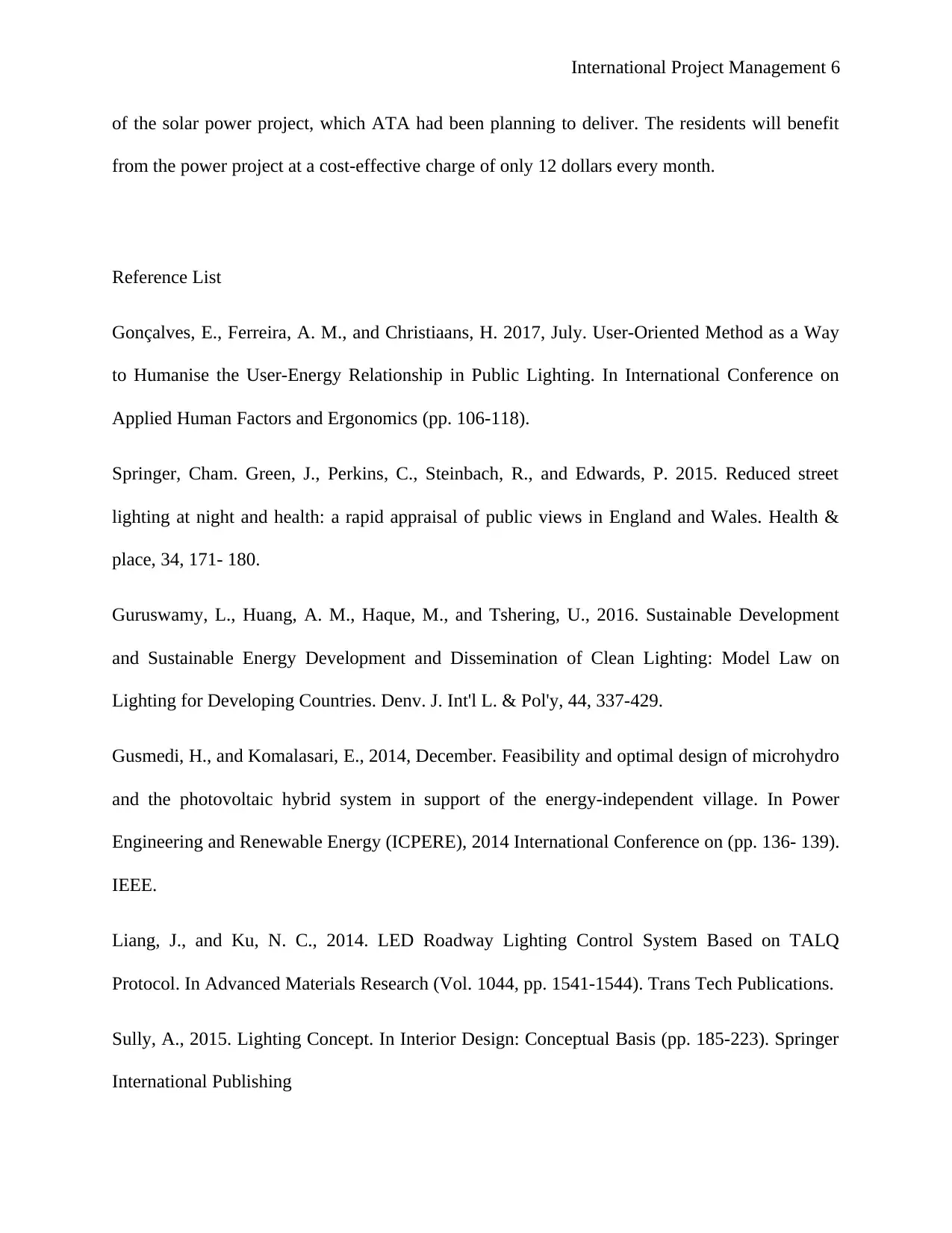
International Project Management 6
of the solar power project, which ATA had been planning to deliver. The residents will benefit
from the power project at a cost-effective charge of only 12 dollars every month.
Reference List
Gonçalves, E., Ferreira, A. M., and Christiaans, H. 2017, July. User-Oriented Method as a Way
to Humanise the User-Energy Relationship in Public Lighting. In International Conference on
Applied Human Factors and Ergonomics (pp. 106-118).
Springer, Cham. Green, J., Perkins, C., Steinbach, R., and Edwards, P. 2015. Reduced street
lighting at night and health: a rapid appraisal of public views in England and Wales. Health &
place, 34, 171- 180.
Guruswamy, L., Huang, A. M., Haque, M., and Tshering, U., 2016. Sustainable Development
and Sustainable Energy Development and Dissemination of Clean Lighting: Model Law on
Lighting for Developing Countries. Denv. J. Int'l L. & Pol'y, 44, 337-429.
Gusmedi, H., and Komalasari, E., 2014, December. Feasibility and optimal design of microhydro
and the photovoltaic hybrid system in support of the energy-independent village. In Power
Engineering and Renewable Energy (ICPERE), 2014 International Conference on (pp. 136- 139).
IEEE.
Liang, J., and Ku, N. C., 2014. LED Roadway Lighting Control System Based on TALQ
Protocol. In Advanced Materials Research (Vol. 1044, pp. 1541-1544). Trans Tech Publications.
Sully, A., 2015. Lighting Concept. In Interior Design: Conceptual Basis (pp. 185-223). Springer
International Publishing
of the solar power project, which ATA had been planning to deliver. The residents will benefit
from the power project at a cost-effective charge of only 12 dollars every month.
Reference List
Gonçalves, E., Ferreira, A. M., and Christiaans, H. 2017, July. User-Oriented Method as a Way
to Humanise the User-Energy Relationship in Public Lighting. In International Conference on
Applied Human Factors and Ergonomics (pp. 106-118).
Springer, Cham. Green, J., Perkins, C., Steinbach, R., and Edwards, P. 2015. Reduced street
lighting at night and health: a rapid appraisal of public views in England and Wales. Health &
place, 34, 171- 180.
Guruswamy, L., Huang, A. M., Haque, M., and Tshering, U., 2016. Sustainable Development
and Sustainable Energy Development and Dissemination of Clean Lighting: Model Law on
Lighting for Developing Countries. Denv. J. Int'l L. & Pol'y, 44, 337-429.
Gusmedi, H., and Komalasari, E., 2014, December. Feasibility and optimal design of microhydro
and the photovoltaic hybrid system in support of the energy-independent village. In Power
Engineering and Renewable Energy (ICPERE), 2014 International Conference on (pp. 136- 139).
IEEE.
Liang, J., and Ku, N. C., 2014. LED Roadway Lighting Control System Based on TALQ
Protocol. In Advanced Materials Research (Vol. 1044, pp. 1541-1544). Trans Tech Publications.
Sully, A., 2015. Lighting Concept. In Interior Design: Conceptual Basis (pp. 185-223). Springer
International Publishing
⊘ This is a preview!⊘
Do you want full access?
Subscribe today to unlock all pages.

Trusted by 1+ million students worldwide
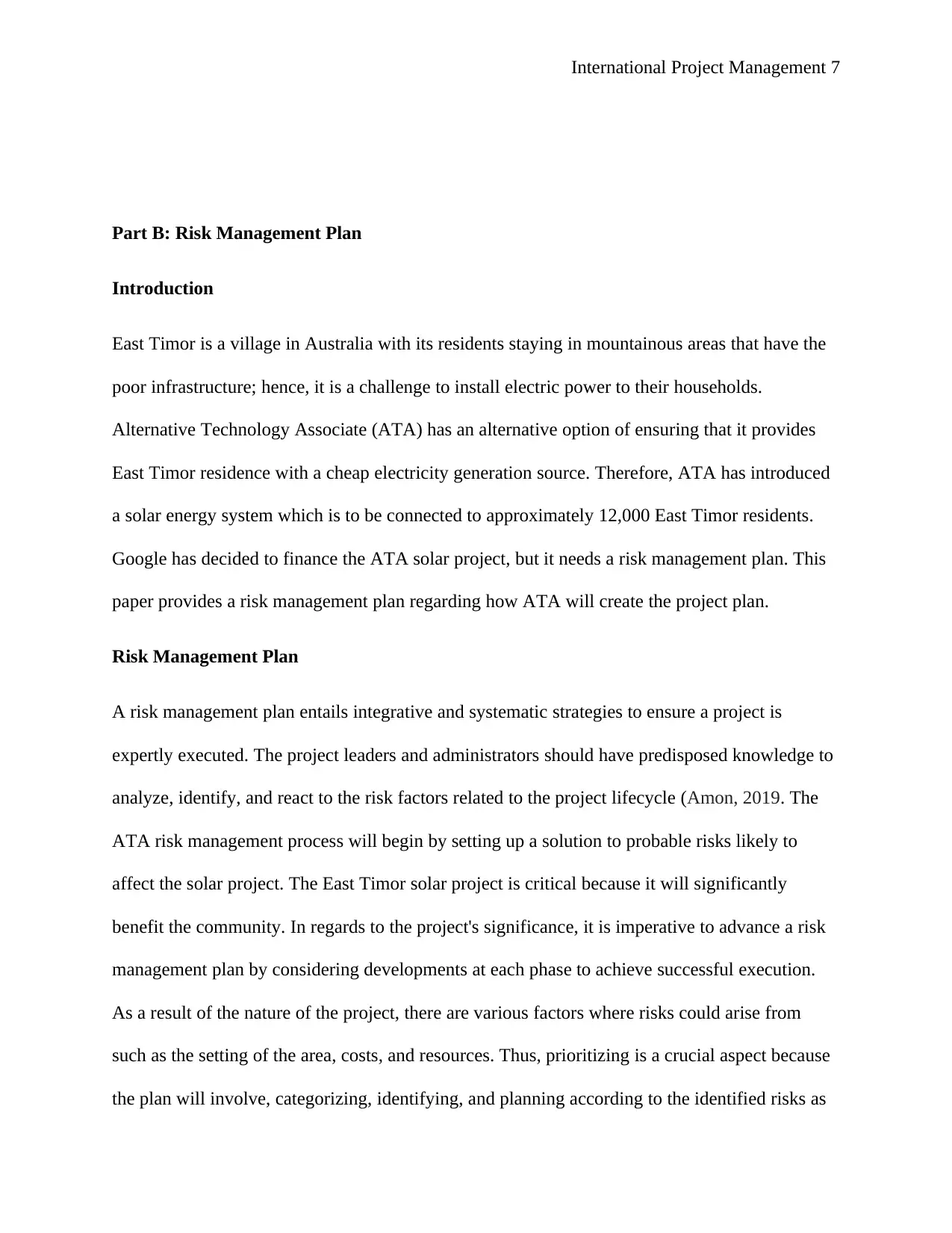
International Project Management 7
Part B: Risk Management Plan
Introduction
East Timor is a village in Australia with its residents staying in mountainous areas that have the
poor infrastructure; hence, it is a challenge to install electric power to their households.
Alternative Technology Associate (ATA) has an alternative option of ensuring that it provides
East Timor residence with a cheap electricity generation source. Therefore, ATA has introduced
a solar energy system which is to be connected to approximately 12,000 East Timor residents.
Google has decided to finance the ATA solar project, but it needs a risk management plan. This
paper provides a risk management plan regarding how ATA will create the project plan.
Risk Management Plan
A risk management plan entails integrative and systematic strategies to ensure a project is
expertly executed. The project leaders and administrators should have predisposed knowledge to
analyze, identify, and react to the risk factors related to the project lifecycle (Amon, 2019. The
ATA risk management process will begin by setting up a solution to probable risks likely to
affect the solar project. The East Timor solar project is critical because it will significantly
benefit the community. In regards to the project's significance, it is imperative to advance a risk
management plan by considering developments at each phase to achieve successful execution.
As a result of the nature of the project, there are various factors where risks could arise from
such as the setting of the area, costs, and resources. Thus, prioritizing is a crucial aspect because
the plan will involve, categorizing, identifying, and planning according to the identified risks as
Part B: Risk Management Plan
Introduction
East Timor is a village in Australia with its residents staying in mountainous areas that have the
poor infrastructure; hence, it is a challenge to install electric power to their households.
Alternative Technology Associate (ATA) has an alternative option of ensuring that it provides
East Timor residence with a cheap electricity generation source. Therefore, ATA has introduced
a solar energy system which is to be connected to approximately 12,000 East Timor residents.
Google has decided to finance the ATA solar project, but it needs a risk management plan. This
paper provides a risk management plan regarding how ATA will create the project plan.
Risk Management Plan
A risk management plan entails integrative and systematic strategies to ensure a project is
expertly executed. The project leaders and administrators should have predisposed knowledge to
analyze, identify, and react to the risk factors related to the project lifecycle (Amon, 2019. The
ATA risk management process will begin by setting up a solution to probable risks likely to
affect the solar project. The East Timor solar project is critical because it will significantly
benefit the community. In regards to the project's significance, it is imperative to advance a risk
management plan by considering developments at each phase to achieve successful execution.
As a result of the nature of the project, there are various factors where risks could arise from
such as the setting of the area, costs, and resources. Thus, prioritizing is a crucial aspect because
the plan will involve, categorizing, identifying, and planning according to the identified risks as
Paraphrase This Document
Need a fresh take? Get an instant paraphrase of this document with our AI Paraphraser
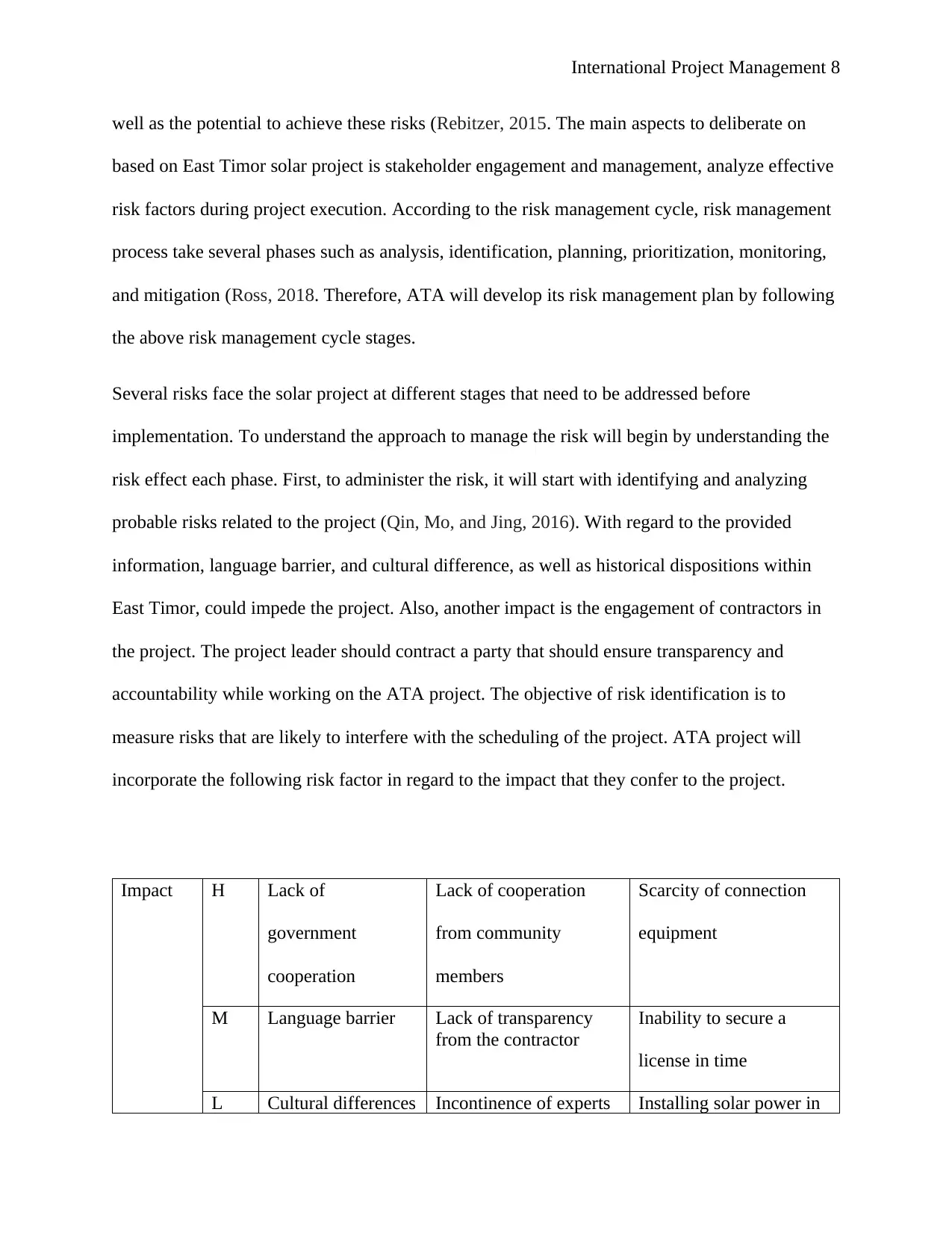
International Project Management 8
well as the potential to achieve these risks (Rebitzer, 2015. The main aspects to deliberate on
based on East Timor solar project is stakeholder engagement and management, analyze effective
risk factors during project execution. According to the risk management cycle, risk management
process take several phases such as analysis, identification, planning, prioritization, monitoring,
and mitigation (Ross, 2018. Therefore, ATA will develop its risk management plan by following
the above risk management cycle stages.
Several risks face the solar project at different stages that need to be addressed before
implementation. To understand the approach to manage the risk will begin by understanding the
risk effect each phase. First, to administer the risk, it will start with identifying and analyzing
probable risks related to the project (Qin, Mo, and Jing, 2016). With regard to the provided
information, language barrier, and cultural difference, as well as historical dispositions within
East Timor, could impede the project. Also, another impact is the engagement of contractors in
the project. The project leader should contract a party that should ensure transparency and
accountability while working on the ATA project. The objective of risk identification is to
measure risks that are likely to interfere with the scheduling of the project. ATA project will
incorporate the following risk factor in regard to the impact that they confer to the project.
Impact H Lack of
government
cooperation
Lack of cooperation
from community
members
Scarcity of connection
equipment
M Language barrier Lack of transparency
from the contractor
Inability to secure a
license in time
L Cultural differences Incontinence of experts Installing solar power in
well as the potential to achieve these risks (Rebitzer, 2015. The main aspects to deliberate on
based on East Timor solar project is stakeholder engagement and management, analyze effective
risk factors during project execution. According to the risk management cycle, risk management
process take several phases such as analysis, identification, planning, prioritization, monitoring,
and mitigation (Ross, 2018. Therefore, ATA will develop its risk management plan by following
the above risk management cycle stages.
Several risks face the solar project at different stages that need to be addressed before
implementation. To understand the approach to manage the risk will begin by understanding the
risk effect each phase. First, to administer the risk, it will start with identifying and analyzing
probable risks related to the project (Qin, Mo, and Jing, 2016). With regard to the provided
information, language barrier, and cultural difference, as well as historical dispositions within
East Timor, could impede the project. Also, another impact is the engagement of contractors in
the project. The project leader should contract a party that should ensure transparency and
accountability while working on the ATA project. The objective of risk identification is to
measure risks that are likely to interfere with the scheduling of the project. ATA project will
incorporate the following risk factor in regard to the impact that they confer to the project.
Impact H Lack of
government
cooperation
Lack of cooperation
from community
members
Scarcity of connection
equipment
M Language barrier Lack of transparency
from the contractor
Inability to secure a
license in time
L Cultural differences Incontinence of experts Installing solar power in
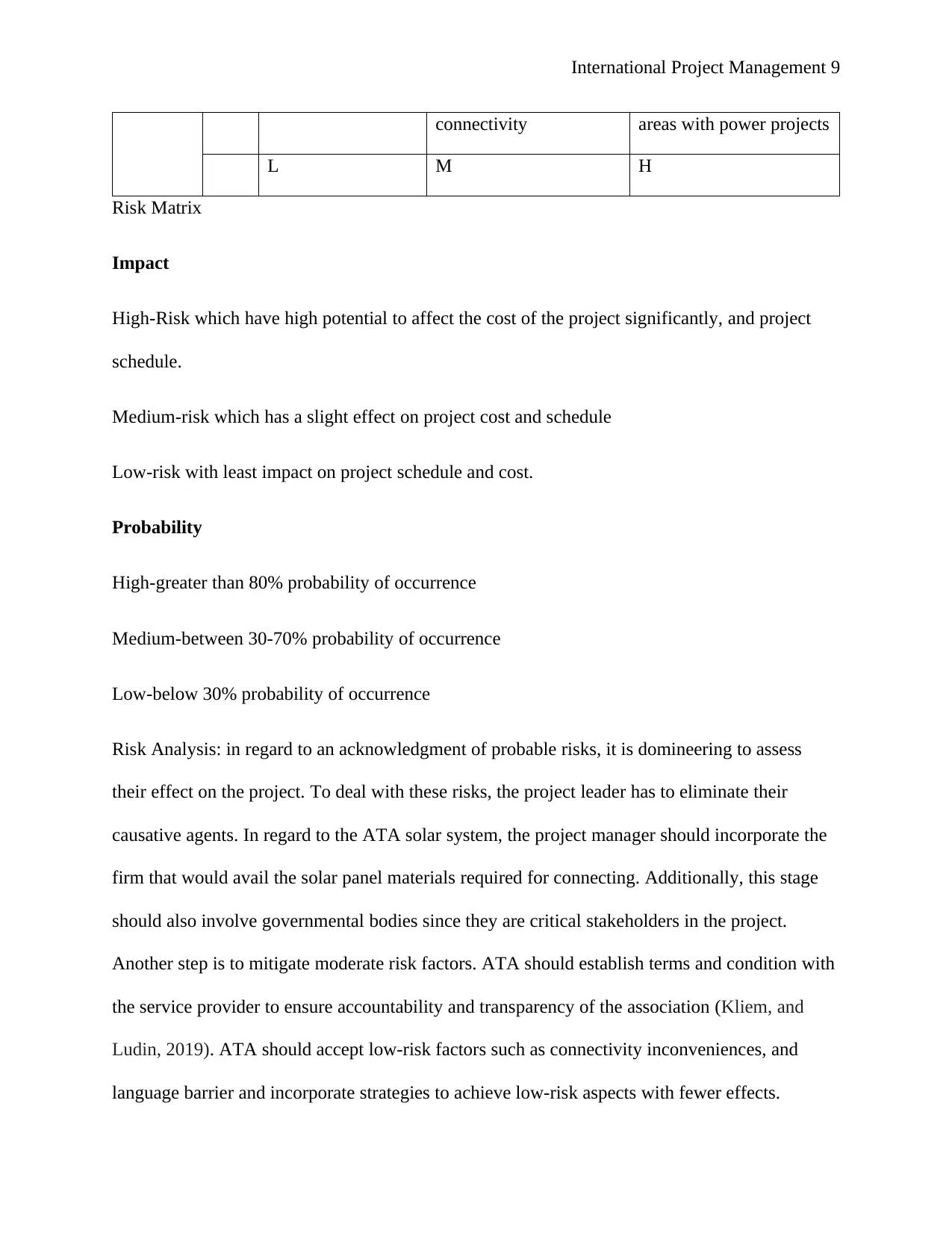
International Project Management 9
connectivity areas with power projects
L M H
Risk Matrix
Impact
High-Risk which have high potential to affect the cost of the project significantly, and project
schedule.
Medium-risk which has a slight effect on project cost and schedule
Low-risk with least impact on project schedule and cost.
Probability
High-greater than 80% probability of occurrence
Medium-between 30-70% probability of occurrence
Low-below 30% probability of occurrence
Risk Analysis: in regard to an acknowledgment of probable risks, it is domineering to assess
their effect on the project. To deal with these risks, the project leader has to eliminate their
causative agents. In regard to the ATA solar system, the project manager should incorporate the
firm that would avail the solar panel materials required for connecting. Additionally, this stage
should also involve governmental bodies since they are critical stakeholders in the project.
Another step is to mitigate moderate risk factors. ATA should establish terms and condition with
the service provider to ensure accountability and transparency of the association (Kliem, and
Ludin, 2019). ATA should accept low-risk factors such as connectivity inconveniences, and
language barrier and incorporate strategies to achieve low-risk aspects with fewer effects.
connectivity areas with power projects
L M H
Risk Matrix
Impact
High-Risk which have high potential to affect the cost of the project significantly, and project
schedule.
Medium-risk which has a slight effect on project cost and schedule
Low-risk with least impact on project schedule and cost.
Probability
High-greater than 80% probability of occurrence
Medium-between 30-70% probability of occurrence
Low-below 30% probability of occurrence
Risk Analysis: in regard to an acknowledgment of probable risks, it is domineering to assess
their effect on the project. To deal with these risks, the project leader has to eliminate their
causative agents. In regard to the ATA solar system, the project manager should incorporate the
firm that would avail the solar panel materials required for connecting. Additionally, this stage
should also involve governmental bodies since they are critical stakeholders in the project.
Another step is to mitigate moderate risk factors. ATA should establish terms and condition with
the service provider to ensure accountability and transparency of the association (Kliem, and
Ludin, 2019). ATA should accept low-risk factors such as connectivity inconveniences, and
language barrier and incorporate strategies to achieve low-risk aspects with fewer effects.
⊘ This is a preview!⊘
Do you want full access?
Subscribe today to unlock all pages.

Trusted by 1+ million students worldwide
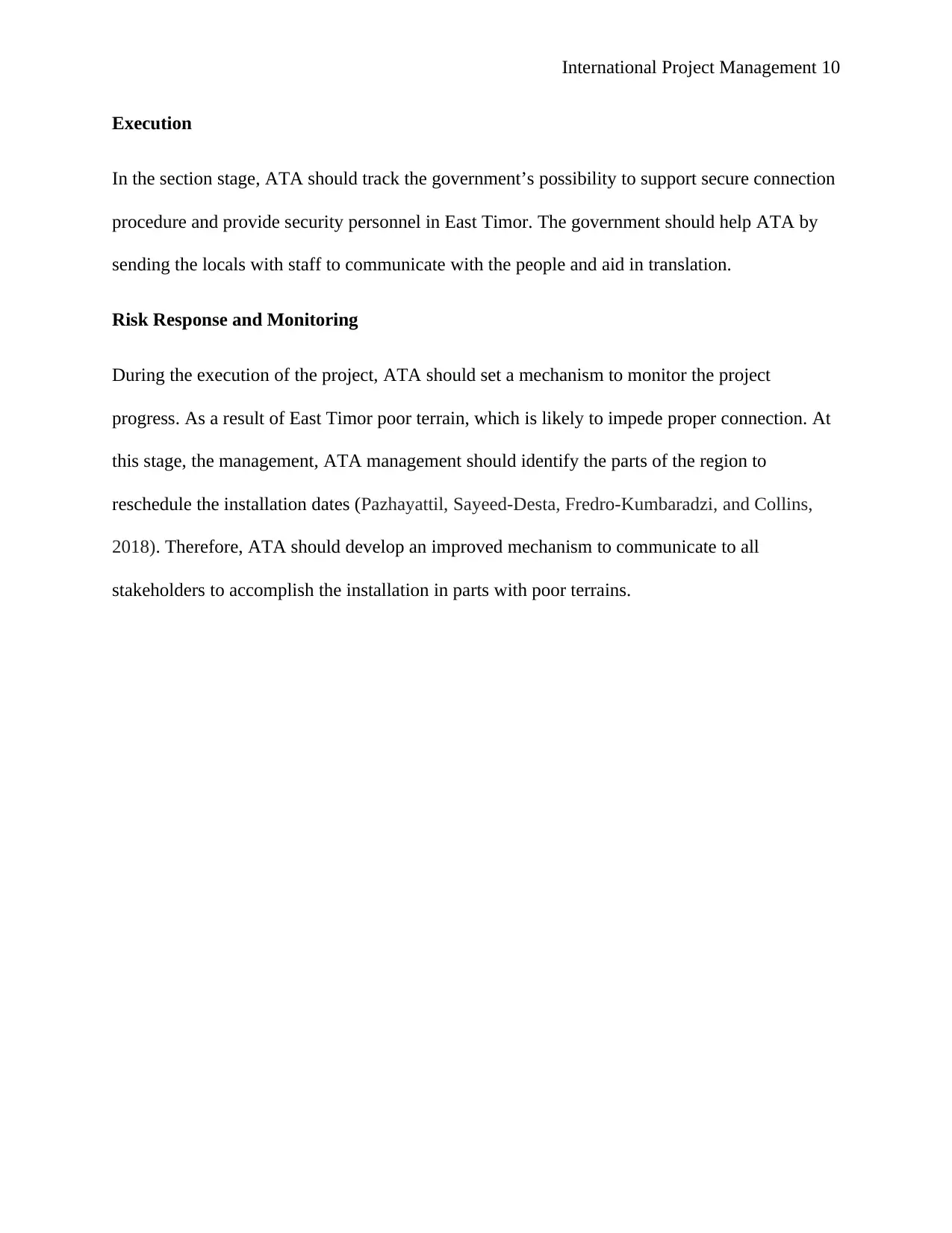
International Project Management 10
Execution
In the section stage, ATA should track the government’s possibility to support secure connection
procedure and provide security personnel in East Timor. The government should help ATA by
sending the locals with staff to communicate with the people and aid in translation.
Risk Response and Monitoring
During the execution of the project, ATA should set a mechanism to monitor the project
progress. As a result of East Timor poor terrain, which is likely to impede proper connection. At
this stage, the management, ATA management should identify the parts of the region to
reschedule the installation dates (Pazhayattil, Sayeed-Desta, Fredro-Kumbaradzi, and Collins,
2018). Therefore, ATA should develop an improved mechanism to communicate to all
stakeholders to accomplish the installation in parts with poor terrains.
Execution
In the section stage, ATA should track the government’s possibility to support secure connection
procedure and provide security personnel in East Timor. The government should help ATA by
sending the locals with staff to communicate with the people and aid in translation.
Risk Response and Monitoring
During the execution of the project, ATA should set a mechanism to monitor the project
progress. As a result of East Timor poor terrain, which is likely to impede proper connection. At
this stage, the management, ATA management should identify the parts of the region to
reschedule the installation dates (Pazhayattil, Sayeed-Desta, Fredro-Kumbaradzi, and Collins,
2018). Therefore, ATA should develop an improved mechanism to communicate to all
stakeholders to accomplish the installation in parts with poor terrains.
Paraphrase This Document
Need a fresh take? Get an instant paraphrase of this document with our AI Paraphraser
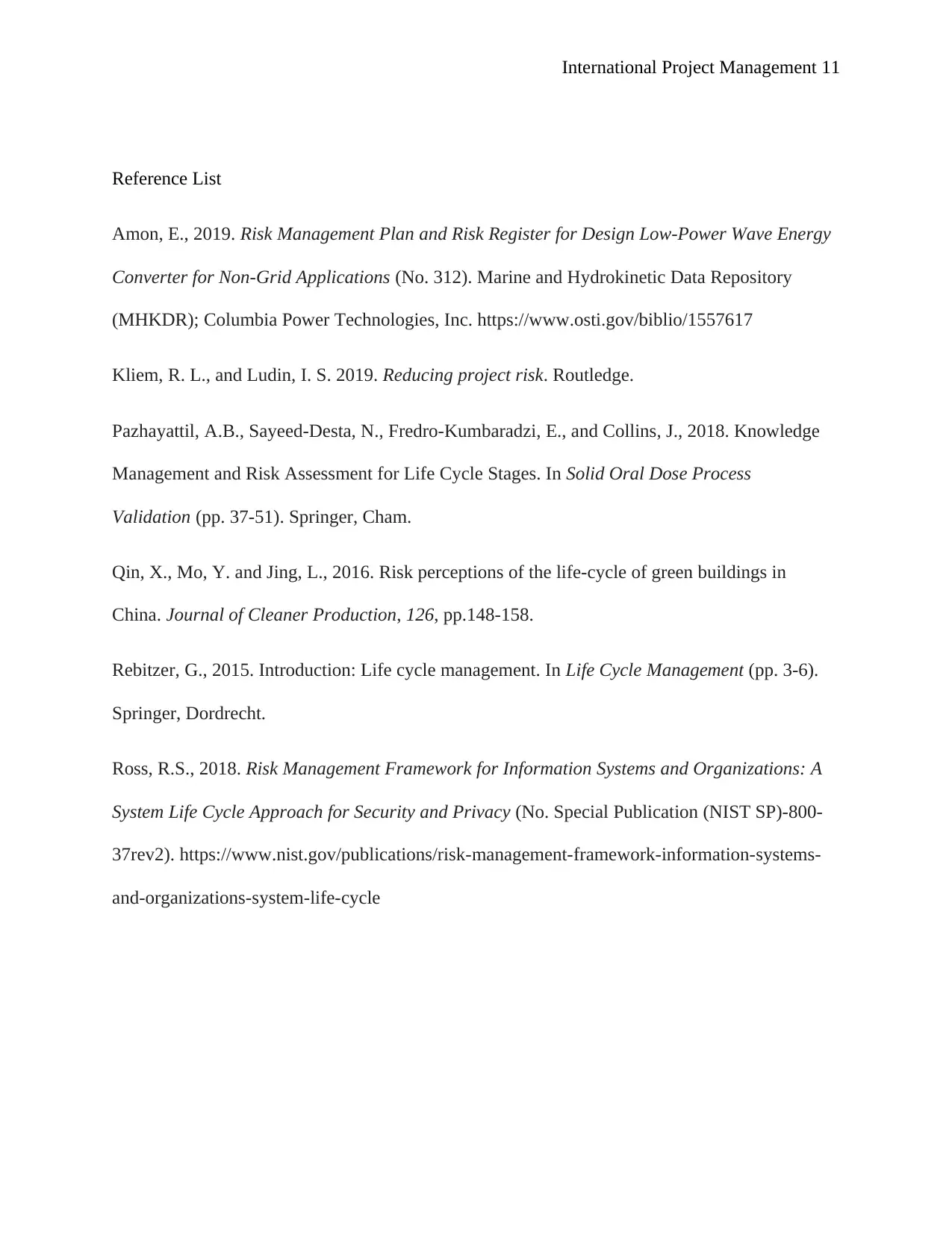
International Project Management 11
Reference List
Amon, E., 2019. Risk Management Plan and Risk Register for Design Low-Power Wave Energy
Converter for Non-Grid Applications (No. 312). Marine and Hydrokinetic Data Repository
(MHKDR); Columbia Power Technologies, Inc. https://www.osti.gov/biblio/1557617
Kliem, R. L., and Ludin, I. S. 2019. Reducing project risk. Routledge.
Pazhayattil, A.B., Sayeed-Desta, N., Fredro-Kumbaradzi, E., and Collins, J., 2018. Knowledge
Management and Risk Assessment for Life Cycle Stages. In Solid Oral Dose Process
Validation (pp. 37-51). Springer, Cham.
Qin, X., Mo, Y. and Jing, L., 2016. Risk perceptions of the life-cycle of green buildings in
China. Journal of Cleaner Production, 126, pp.148-158.
Rebitzer, G., 2015. Introduction: Life cycle management. In Life Cycle Management (pp. 3-6).
Springer, Dordrecht.
Ross, R.S., 2018. Risk Management Framework for Information Systems and Organizations: A
System Life Cycle Approach for Security and Privacy (No. Special Publication (NIST SP)-800-
37rev2). https://www.nist.gov/publications/risk-management-framework-information-systems-
and-organizations-system-life-cycle
Reference List
Amon, E., 2019. Risk Management Plan and Risk Register for Design Low-Power Wave Energy
Converter for Non-Grid Applications (No. 312). Marine and Hydrokinetic Data Repository
(MHKDR); Columbia Power Technologies, Inc. https://www.osti.gov/biblio/1557617
Kliem, R. L., and Ludin, I. S. 2019. Reducing project risk. Routledge.
Pazhayattil, A.B., Sayeed-Desta, N., Fredro-Kumbaradzi, E., and Collins, J., 2018. Knowledge
Management and Risk Assessment for Life Cycle Stages. In Solid Oral Dose Process
Validation (pp. 37-51). Springer, Cham.
Qin, X., Mo, Y. and Jing, L., 2016. Risk perceptions of the life-cycle of green buildings in
China. Journal of Cleaner Production, 126, pp.148-158.
Rebitzer, G., 2015. Introduction: Life cycle management. In Life Cycle Management (pp. 3-6).
Springer, Dordrecht.
Ross, R.S., 2018. Risk Management Framework for Information Systems and Organizations: A
System Life Cycle Approach for Security and Privacy (No. Special Publication (NIST SP)-800-
37rev2). https://www.nist.gov/publications/risk-management-framework-information-systems-
and-organizations-system-life-cycle
1 out of 11
Related Documents
Your All-in-One AI-Powered Toolkit for Academic Success.
+13062052269
info@desklib.com
Available 24*7 on WhatsApp / Email
![[object Object]](/_next/static/media/star-bottom.7253800d.svg)
Unlock your academic potential
Copyright © 2020–2025 A2Z Services. All Rights Reserved. Developed and managed by ZUCOL.





